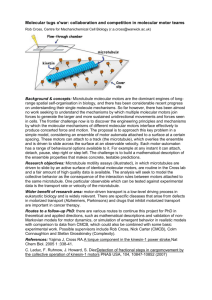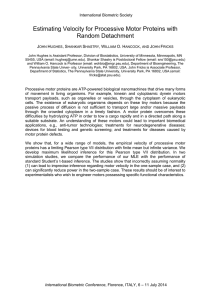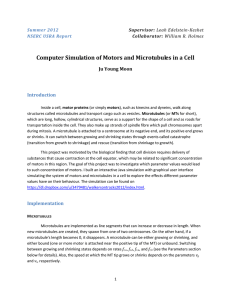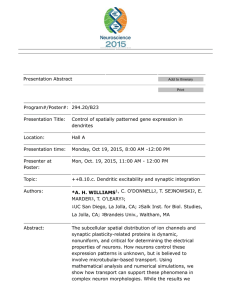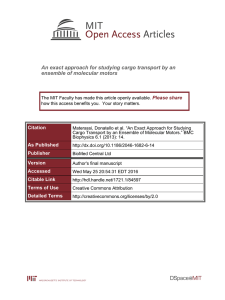PDE Models of Molecular Motors 1 Introduction Summer 2014 NSERC USRA Report
advertisement
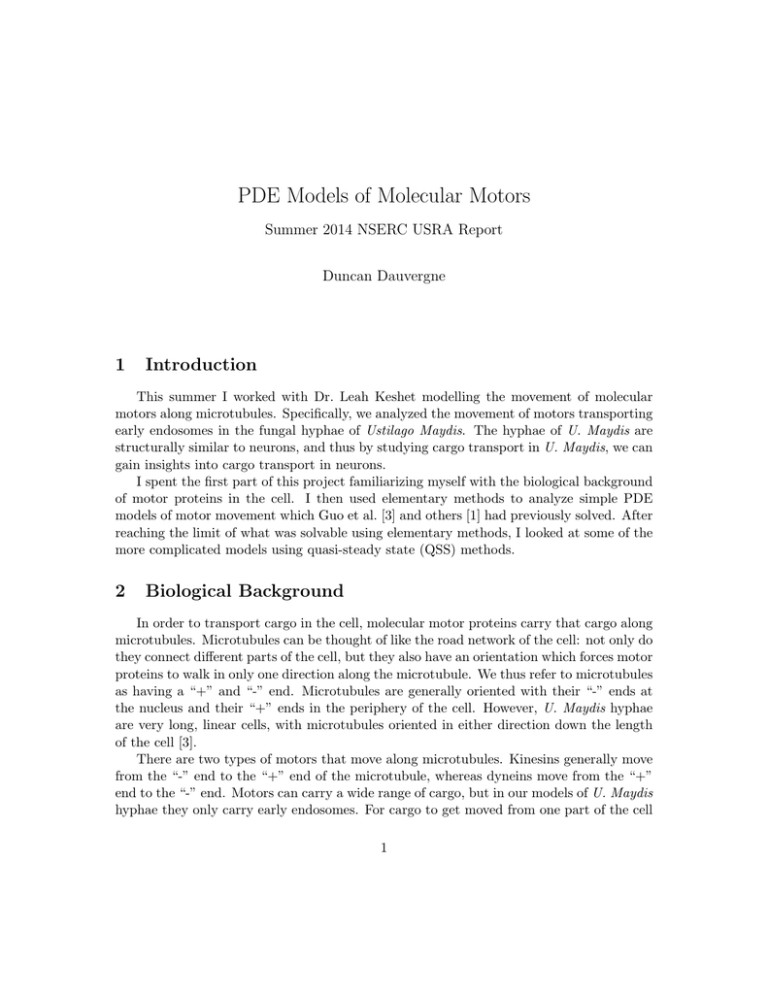
PDE Models of Molecular Motors Summer 2014 NSERC USRA Report Duncan Dauvergne 1 Introduction This summer I worked with Dr. Leah Keshet modelling the movement of molecular motors along microtubules. Specifically, we analyzed the movement of motors transporting early endosomes in the fungal hyphae of Ustilago Maydis. The hyphae of U. Maydis are structurally similar to neurons, and thus by studying cargo transport in U. Maydis, we can gain insights into cargo transport in neurons. I spent the first part of this project familiarizing myself with the biological background of motor proteins in the cell. I then used elementary methods to analyze simple PDE models of motor movement which Guo et al. [3] and others [1] had previously solved. After reaching the limit of what was solvable using elementary methods, I looked at some of the more complicated models using quasi-steady state (QSS) methods. 2 Biological Background In order to transport cargo in the cell, molecular motor proteins carry that cargo along microtubules. Microtubules can be thought of like the road network of the cell: not only do they connect different parts of the cell, but they also have an orientation which forces motor proteins to walk in only one direction along the microtubule. We thus refer to microtubules as having a “+” and “-” end. Microtubules are generally oriented with their “-” ends at the nucleus and their “+” ends in the periphery of the cell. However, U. Maydis hyphae are very long, linear cells, with microtubules oriented in either direction down the length of the cell [3]. There are two types of motors that move along microtubules. Kinesins generally move from the “-” end to the “+” end of the microtubule, whereas dyneins move from the “+” end to the “-” end. Motors can carry a wide range of cargo, but in our models of U. Maydis hyphae they only carry early endosomes. For cargo to get moved from one part of the cell 1 to another, it will first attach to multiple molecular motors and then these motors will attach to microtubules and have a “tug-of-war” to dictate what direction the cargo moves [8]. At any given point, only a certain portion of the motors attached to a piece of cargo will be simultaneously attached to a microtubule, so figuring out the distribution of cargo throughout the cell can quickly become an arduous mathematical task. 3 PDE Models In order to model motor movement using PDEs, we made the assumption that motor concentrations are so large that we can consider motor distributions to be continuous. In the PDE models of motor proteins that we devised, there are two ways that motor proteins and cargo can move. They can move at a constant velocity along microtubule, and they can diffuse freely in the cytosol. In addition, motors can transition between diffusing states and microtubule-bound states, and can switch onto microtubules of the opposite orientation. All the PDEs we used were modifications of the one-dimensional conservation equation, ∂c(x,t) = − ∂J(x,t) ± σ(x, t), where c(x, t) is the concentration of particles, J(x, t) is the ∂t ∂x flux of the particles and σ(x, t) is a source/sink term coming from state transitions. The σ(x, t)-term means that the differential equations are coupled together creating a system of PDEs. The main model of motor movement in U. Maydis that Dr. Keshet and I studied involved three levels of organization. At the base level, we calculated an underlying microtubule distribution based on certain assumptions about spatial control of microtubule nucleation. At the second level, we calculated the distribution of dyneins in the fungal hyphae given this microtubule distribution. At the third level, we calculated the distribution of early endosomes in the cell given both the microtubule distribution in the first level and the dynein distribution in the second level. Due to the complexity of having a three-layer model, Guo et al. originally calculated the distributions numerically [3]. While a numerical calculation can allow us to see what a distribution will look like, using a QSS approximation can give us a more precise idea of exactly how certain parameters affect that distribution. The QSS approximation we used turns a system of coupled PDEs into a single Fokker∂u ∂2u Planck equation, ∂u ∂t = −V ∂x + D ∂x2 . Here u(x, t) is the total motor density in the cell. The basic idea is that when the state transitions are much faster than the velocity of motors travelling down microtubules, then at each point along the cell the motors are essentially in equilibrium. Mathematically, if p is our vector of motor densities and A is the matrix of state transitions, then p = pss + w1 + O(2 ), where pss ∈ Null(A) and 1 is roughly equal to velocity divided by transition rate. We can then use this approximation for p to derive the above Fokker-Planck equation, where V is the average weighted velocity of the motors and D is the effective diffusion. A much more detailed description of these methods is given by Bressloff and Newby [2]. 2 By performing this QSS reduction on the PDEs in our model, I was able to replicate the results of my exact solutions in the rare case where exacts solutions were obtainable and when the transition rates were sufficiently fast. I was also able to replicate the results of the numerics in cases with appropriate transition rates, and in doing so gained additional insight into how different parameters affect motor and endosome distributions. References 1. Blasius, T. L., Reed, N., Slepchenko, B. M., and Verhey, K. J. (2013). Recycling of kinesin-1 motors by diffusion after transport. PloS one, 8(9):e76081. 2. Bressloff, P. C. and Newby, J. M. (2013). Stochastic models of intracellular transport. Reviews of Modern Physics, 85(1):135. 3. Gou, J., Edelstein-Keshet, L., and Allard, J. (2014). Mathematical model with spatially uniform regulation explains long-range bidirectional transport of early endosomes in fungal hyphae. Molecular Biology of the Cell, 25(16):2408–2415. 4. Newby, J. and Bressloff, P. C. (2010a). Local synaptic signaling enhances the stochastic transport of motor-driven cargo in neurons. Physical biology, 7(3):036004. 5. Newby, J. M. and Bressloff, P. C. (2010b). Quasi-steady state reduction of molecular motor-based models of directed intermittent search. Bulletin of mathematical biology, 72(7):1840–1866. 6. Reed, M. C., Venakides, S., and Blum, J. J. (1990). Approximate traveling waves in linear reaction-hyperbolic equations. SIAM Journal on Applied Mathematics, 50(1):167– 180. 7. Schuster, M., Kilaru, S., Fink, G., Collemare, J., Roger, Y., and Steinberg, G. (2011). Kinesin-3 and dynein cooperate in long-range retrograde endosome motility along a nonuniform microtubule array. Molecular biology of the cell, 22(19):3645–3657. 8. Shubeita, G. and Gross, S. (2012). Intracellular transport: relating single-molecule properties to in vivo function. Comprehensive Biophysics, 1. 3

